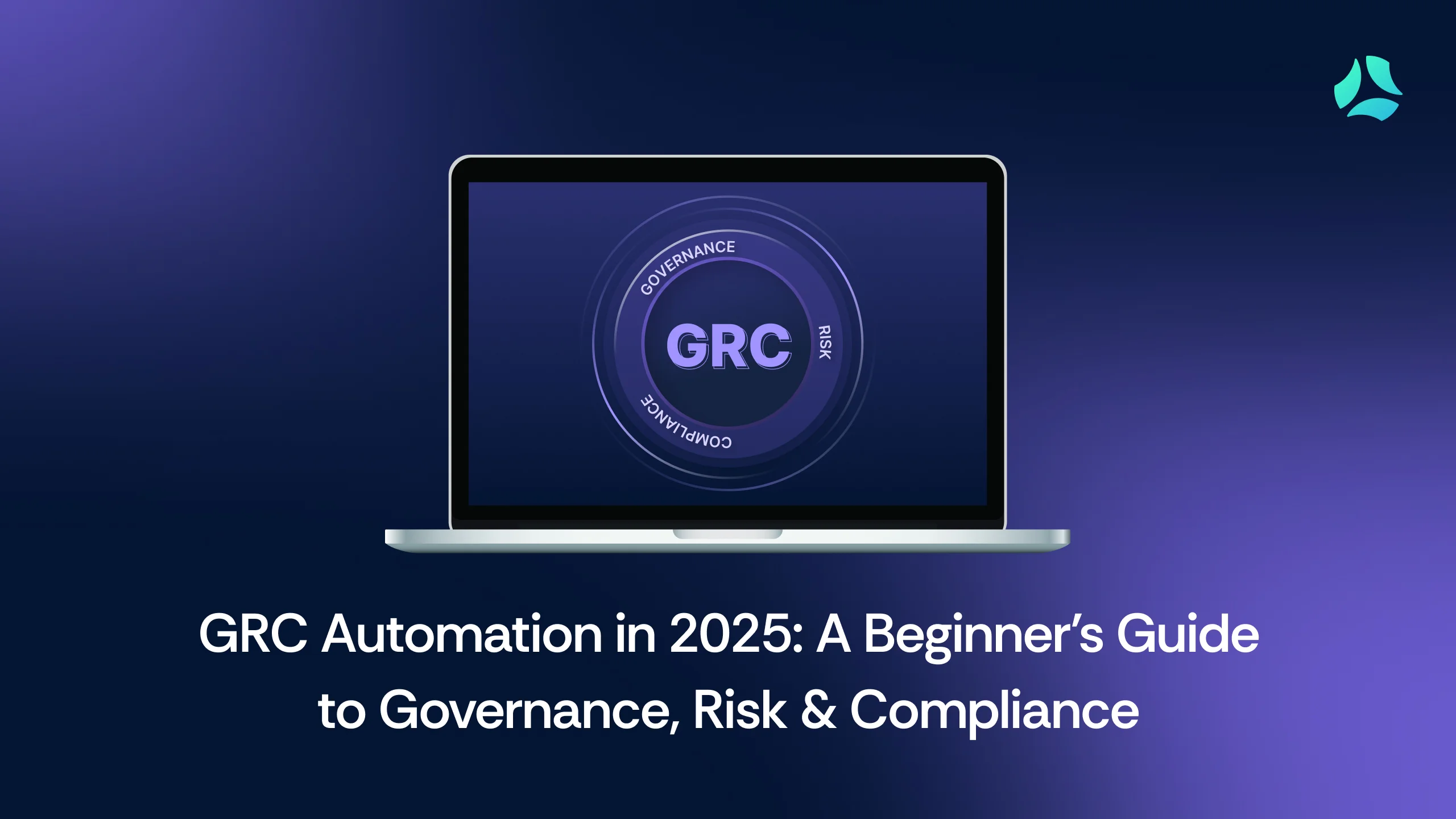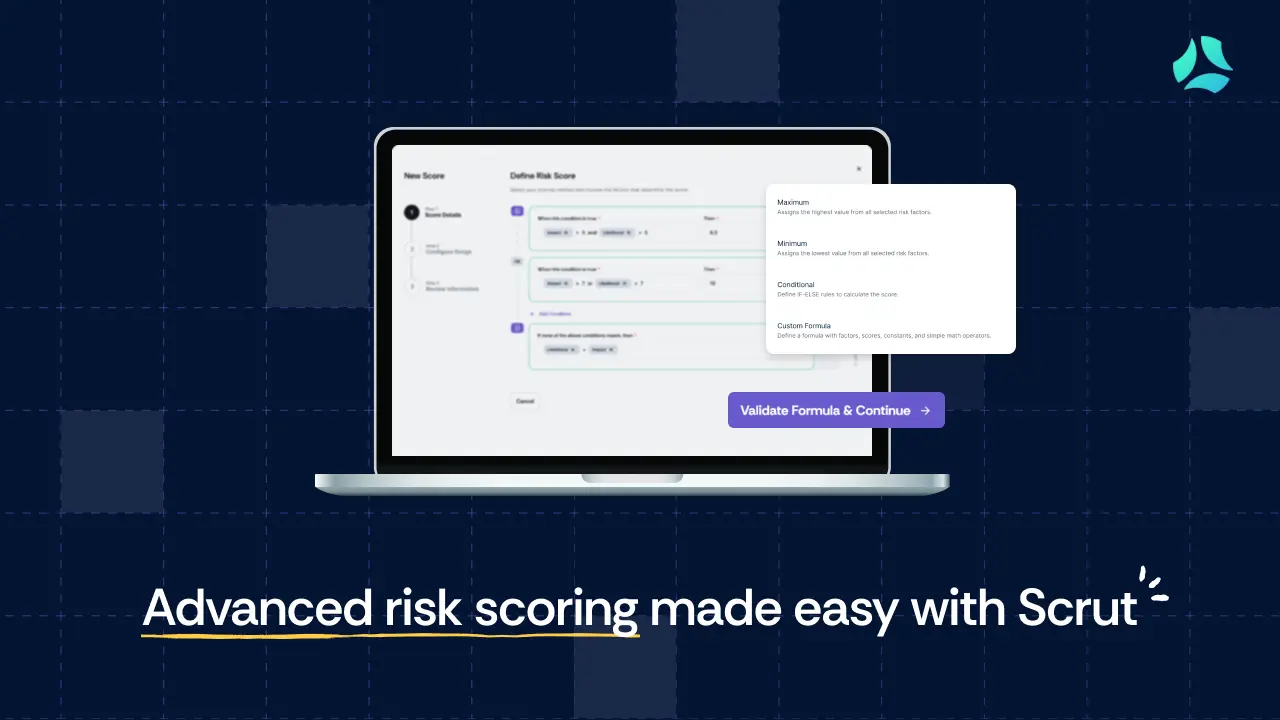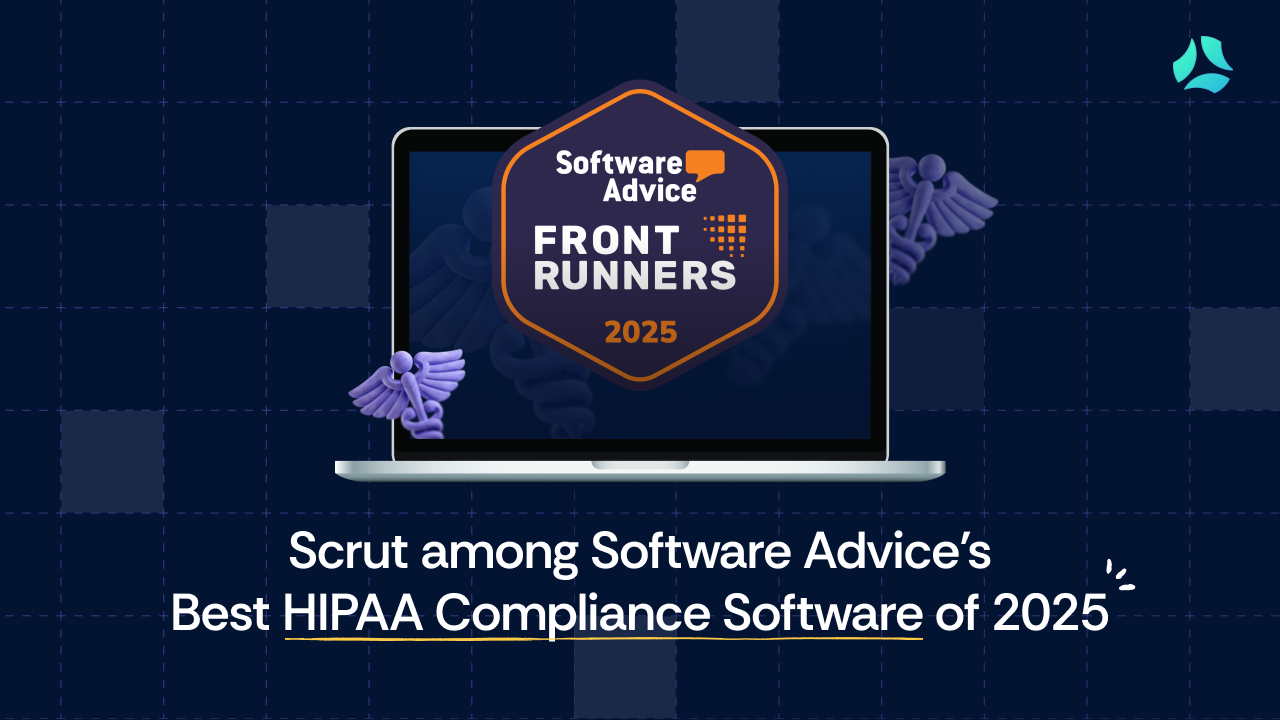GRC automation in 2025: A practical guide to streamlined compliance and risk management

Many businesses view governance, risk, and compliance (GRC) as merely a series of tedious and time-consuming processes. But when done right, GRC delivers tangible business value far beyond mere compliance with regulatory requirements.
With a strong GRC program, you get faster risk mitigation, smarter decision-making, and a more unified approach to risk and compliance. Most importantly, you build a compliance-first culture across your organization, enabling sustained business growth and success.
But how can you overcome the monotony and delays of manual GRC processes? The solution is using GRC automation. It eliminates spreadsheets and manual tasks, giving teams real-time dashboards, auto-collected evidence, and faster audit cycles.
Let’s explore GRC automation further and how your organization can use this technology to make your processes more efficient.
What is GRC automation?
GRC automation refers to using specialized GRC software to automate, centralize, monitor, and document the various GRC processes, integrating all three components—governance, risk, and compliance—into a unified framework.
Traditional manual workflows often rely on fragmented spreadsheets, siloed communication, and time-consuming administrative procedures.
GRC automation, on the other hand, provides a single source of truth, streamlines routine tasks, and creates repeatable processes that save your team significant time and effort.
It also allows your business to efficiently navigate constantly evolving regulatory requirements and gain real-time insights into risk and compliance posture, building an organizational culture of transparency and accountability.
For example, here’s how Balboa, a five-decades-old corporate travel management company, adopted Scrut to “build GRC processes according to industry best practices.”
Balboa’s objective: Compliance with SOC 2, ISO 27001:2022, and GDPR.
Problems they faced
- Manually building policies and collecting evidence, leading to inadequate visibility into controls status, compliance progress, and employee acceptance.
- Siloed vendor management across business units, with labor-intensive document collection, disconnected vendor assessments, and no due diligence evidence.
- Managing risks across isolated spreadsheets, which hindered visibility into their impact on controls, forcing manual and time-consuming risk assessments and categorizations.
- Difficulty in audit management, with evidence sent to auditors via email and slow response to requests due to scattered controls and artifacts.
Scrut’s advanced GRC automation solution

Scrut promptly took on the challenge and redesigned Balboa’s GRC processes with its Scrut platform:
- Fast-tracked compliance workflows: Scrut helped them quickly build policies from pre-built, framework-aligned policies and customize them with an in-line editor.
- Streamlined vendor handling: Scrut offered a central hub for third-party vendors, automating due diligence through activity logs and ensuring compliance via customizable questionnaires and reminders.
- Simplified risk management: Scrut enabled Balboa to import its risk register into the platform, automatically map risks to framework controls, and prioritize them based on automated scores.
- Accelerated audits: Scrut accelerated Balboa's audit process by granting auditors platform access to review artifacts and controls, and the ability to provide findings and request additional evidence.
As a result, Balboa was able to modernize and advance their GRC processes with simplified vendor assessments, proactive risk mitigation, and streamlined stakeholder collaboration.
What parts of a GRC process you can automate
Automation is the strategic backbone of an effective GRC system. It eliminates manual burdens and transforms siloed processes into a centralized, scalable system that grows with your business.
Here’s a quick overview of how GRC automation can streamline your GRC processes:
Now, let’s discuss in detail how you can improve your processes with a powerful GRC automation platform:
Compliance monitoring and screening for missing controls or compliance gaps
Compliance isn’t a one-off task. Controls often fail or get circumvented. Automated monitoring continuously tests controls for effectiveness (e.g., checks for misconfigurations in a cloud environment or scans code for vulnerabilities) and identifies compliance gaps. Upon detecting deviations, some software auto-alerts respective owners to initiate remediation, helping to maintain constant compliance.
Identifying and assessing potential risks
Effective GRC automation tools provide integrated risk-handling capabilities. They can include a pre-built risk library and the option to import risks from a file, allowing you to jump-start your risk management program. Some GRC automation software also provides workflows to create risks directly from cloud tests or vendor assessments, and add residual risks as well.
For risk assessment, the platform provides a centralized risk register, standardized risk assessment templates, and automated workflows for analyzing and evaluating risks. It also enables your team to prioritize critical risks with automated scores based on predefined risk frameworks, which can be customized based on your organization’s risk appetite.
Managing policy documents
Diverse risks, evolving regulatory requirements, organizational silos, inconsistent policy creation and enforcement, and a lack of accountability can hinder GRC efforts. A GRC automation platform provides a centralized policy module to streamline the entire policy lifecycle.
It comes with pre-built, customizable policy templates aligned with popular regulatory frameworks, expediting policy creation, modification, and enforcement. It also provides a central policy repository with automated distribution and acceptance tracking.
Maintaining audit documentation and evidence
The audit process is often cumbersome and time-consuming, involving manual document preservation, scattered spreadsheets, disorganized network drives, and inefficient communication between auditors and auditees.
However, GRC automation tools can help you effectively address these challenges. By automating evidence collection, centralizing documentation, maintaining detailed audit trails, and facilitating collaboration between stakeholders within the platform, they reduce audit fatigue and accelerate audit readiness.
Collecting and assessing third-party risk information
As businesses become more interconnected, risks are no longer limited to internal operations. They also extend to your vendors and third-party partners, whose security and compliance gaps can impact your digital infrastructure. When you integrate your system with theirs, you effectively inherit their risks.Risks are not limited to internal departments; they extend to vendors and third-party associations as the corporate world gets more digitized, globalized, and interconnected.
These external risks may seep in unnoticed if managed poorly. The GRC automation software can:
- Simplify vendor profiling with automated, customizable risk scoring.
- Centralize vendor document collection and storage for audit preparation.
- Streamline vendor assessment with automated questionnaire generation, distribution with reminders, and response tracking.
- Auto-map third-party risks to controls and controls to specific framework requirements.
Completing security questionnaires for potential clients
Security questionnaires are vital for demonstrating trust and compliance. However, manually responding to these questions is time-consuming, resource-intensive, and prone to inaccuracies.
Conversely, response automation effectively tackles this challenge by using a centralized, up-to-date knowledge base for consistent and faster answers. The automation tool maps the security questionnaire to the existing knowledge repository and pre-fills the responses, which can be customized as required. It also tracks the progress of each questionnaire and sends reminders for pending responses.
Automation enables you to quickly respond to queries from clients or partners with improved accuracy, consistency, and scalability for high volumes. This strengthens governance and supports transparency, helping to establish mutually trustworthy partnerships.
Tracking risk mitigation and compliance tasks
A GRC automation solution offers streamlined risk mitigation and compliance workflows. It lets you assign remediation tasks with auto-recommended corrective steps to relevant personnel, along with automated notifications and reminders, for quick closure. Real-time dashboards with visual charts and graphs enable mitigation progress tracking, improving accountability across GRC functions.
Step-by-Step: How to get started with GRC automation
Successfully implementing GRC automation across the organization might require a complete overhaul of your existing GRC processes. The following step-by-step guide will help you deploy an effective GRC automation program:
1. Assess your current GRC state
Start by documenting the existing GRC processes and evaluating them for their effectiveness—or rather, ineffectiveness. Conduct employee surveys and extensive meetings with department heads and other key personnel to understand how they perform GRC functions, the tools they use, the data they handle, and the challenges they face.
This will help you gauge the maturity of each process and identify inefficient tasks, effort duplication, and communication bottlenecks. With this information, you can pinpoint high-volume, repetitive processes ripe for automation and other areas for improvement.
2. Define your GRC objectives and prioritize tasks to automate
A haphazard approach to GRC automation can lead to wasted resources and missed opportunities. To make it successful, set clear goals for automation that align with your overall business objectives.
Assemble a team of GRC experts, IT personnel, and compliance managers to evaluate current GRC challenges and define the scope of automation. Conduct brainstorming sessions to determine your specific automation needs and frame SMART (specific, measurable, achievable, relevant, and time-bound) goals, setting clear expectations that focus on key improvement areas.
For example, one of your GRC goals can be “to automate 50% of control testing for SOC 2 compliance by the end of Q3” or “to reduce audit preparation time by 20% within 6 months.”
Additionally, by employing a framework like ISO 31000 for risk management, you can standardize your approach to risk assessment.
To further optimize GRC automation efforts, collaborate with relevant stakeholders to identify critical GRC needs and prioritize tasks for automation based on their impact on established goals and overall return on investment (ROI).
3. Select the right GRC automation tool
Since there are dozens of GRC automation platforms out there, it’s crucial to choose the right one based on your specific objectives.
You can start by analyzing the top GRC tools to see which fits your automation needs best and provides the essential features that enable you to quickly achieve your GRC goals.
Evaluate each platform by considering factors like cost efficiency, quick deployment, integration capabilities, scalability, vendor reputation, customer support, and user reviews.
Additionally, you could review its AI capabilities, such as:
- Automatically mapping controls to frameworks like NIST CSF, SOC 2, and more.
- Automatically assigning remediation tasks with specific suggestions for fixes.
- Auto-generation of vendor questionnaires and analysis of vendor responses with risk scoring.
- Auto-filling security questionnaires from prospective partners.
It would also help to check whether the AI-powered platform is ISO 42001-certified to ensure your confidential data is safe.
You can even use tools with a free trial or book a demo to determine if they can meet your unique GRC needs.
To ensure scalability, many growing companies choose comprehensive GRC automation platforms with features that extend beyond their GRC scope. For instance, Scrut offers GRC automation solutions designed to scale with businesses, serving everyone from early-stage startups to large enterprises.
4. Plan, implement, and test your GRC program
Planning is one of the most crucial steps of a GRC program; a strategic implementation is essential to avoid common GRC automation pitfalls, such as poor data quality, ineffective workflows, and collaboration silos.
Develop an implementation plan with a detailed roadmap for your GRC automation journey. This includes defining clear timelines, assigning responsibilities, allocating resources, setting milestones, and establishing communication channels.
Next, start implementing your GRC automation platform. This involves system configuration, including tasks such as defining user roles, designing GRC workflows (e.g., risk assessments and policy approvals), and customizing reports and dashboards to meet your business’s unique requirements. Migrate the data, integrate with existing business tools (e.g., HRIS, CRM, SIEMs, IAM tools), and set up automated control tests and deviation alerts.
Finally, thoroughly test the system and processes to validate their effectiveness and accuracy before going live.
5. Train your team and manage change
Adapting people to profound organizational changes, such as those brought by GRC automation, is challenging. Identify key personnel from each division involved in GRC activities and train them to use the automation platform efficiently.
To ensure continuous user support and proactive issue resolution, leverage the in-built training module and expert assistance that some GRC platforms provide. This enables you to get valuable user feedback and insights into the effectiveness of GRC automation and improve the system before rolling it out across the organization.
6. Monitor and optimize
With the implementation of GRC automation, the journey has just begun. You should regularly monitor the progress of your automation efforts and whether they adapt well to changing scenarios, such as regulatory updates and evolving business needs.
Define and track key process indicators (KPIs), including policy acknowledgement rate, compliance violation rate, risk assessment durations, time to resolve issues, cost of compliance, vendor onboarding duration, and audit preparation time.
Regularly assess the ongoing GRC automation program using these KPIs and make necessary changes to improve efficiency and accuracy. Keep users in the loop and address their concerns to continuously optimize your GRC automation system.
Key challenges in GRC Automation and how to overcome them
As with all strategies and technologies, GRC automation brings forth a few challenges that, if ignored, could lead to GRC program failure.
Let’s take a look at these challenges and how to overcome them:
Lack of leadership buy-in
Without sufficient leadership support, your GRC program could suffer from insufficient funding, scarce resources, and deprioritization, ultimately hindering organization-wide adoption.
Also, business leaders may sometimes underestimate the impact of business risks, including economic instability, disruptive technologies, constantly evolving regulatory requirements, potential supply chain disruptions, and increasing sophistication of cyberattacks.
Moreover, a new kind of risk has emerged in recent years: the rapid adoption of AI and Large Language Models (LLMs). The use of these technologies, especially by third-party vendors, introduces fresh challenges related to data privacy, intellectual property, algorithmic bias, and sophisticated AI-powered cyberattacks. What you need is a proactive GRC approach—establishing clear AI usage policies and continuously monitoring emerging risks. But without leadership buy-in, you may struggle with these threats, leaving your organization vulnerable to compliance failures.
To involve senior executives, you should demonstrate the adverse impact of these risks and tie it to poor business growth and ROI. Explain how manual GRC is inefficient and could lead to non-compliance, which, in turn, may result in regulatory fines and reputational damage.
Data integration and silos
Integrating a new platform with existing business tools can be complex and risks data integrity due to organizational silos, incompatible systems, and poorly implemented or misconfigured APIs.
To overcome this, select a GRC automation tool that offers multiple built-in, reliable integrations for popular business tools and robust APIs for customized integrations. Also, implement strong data validation and reconciliation processes to ensure data accuracy, completeness, and consistency across all integrated systems.
Resistance to change
Most employees are wary of changes, and GRC automation is a significant one, with concerns about job displacement and the learning curve associated with new systems. It’s essential to achieve user buy-in by convincing them of the transformation benefits.
Clearly communicate the need for the shift and improve user engagement through adequate training and pilot programs. Explain how it can improve efficiency and accuracy, decrease manual burdens, automate tedious tasks, enhance collaboration, and reduce stress.
Initial setup and complexity
Even after acquiring a robust GRC automation platform, there can still be challenges related to configuring it according to your unique organizational needs and implementing it across the organization.
To overcome this, you can begin by adopting a phased approach, applying automation to critical GRC processes first, and seeking vendor support when stuck.
Data security and privacy
Another crucial concern is maintaining the privacy and security of sensitive information in an automated platform. Regulatory bodies across various regions dictate distinct data handling, storage, and transfer requirements, making it difficult to comply with multiple frameworks.
Choose a trusted and experienced GRC automation platform vendor that offers strong data encryption, granular access controls, and out-of-the-box mapping features that enable data handling based on specific security standards and regional regulations, such as SOC 2, HIPAA, and GDPR.
Cost of implementation
The upfront cost of acquiring GRC automation software may be prohibitive for some businesses, especially startups and SMEs. Nevertheless, the cost of compliance violations, data breaches, legal fines, and lost credibility may outweigh that of adopting GRC automation.
To avoid this uncertainty, carefully evaluate the ROI and long-term cost-effectiveness before making a switch. Initially, you can start your automation journey with essential features and later grow your GRC efforts with a scalable solution.
How can Scrut help with GRC automation?
Implementing a GRC automation program is not a one-time job; it’s an essential, ongoing company-wide function that requires careful planning, the right automation platform, and effective change management with continuous monitoring.
If you’re looking for a comprehensive GRC automation solution, look no further. Scrut’s platform is a leading GRC solution designed for businesses of all sizes, from startups to enterprises.
By strategically leveraging Scrut’s platform, you can centralize all your governance, risk, and compliance processes in a single, accessible platform. This not only helps you improve operational efficiency and streamline workflows but also enables you to reduce business risks, maintain constant compliance, and become audit-ready quickly.
Scrut stands out with several automation features, including:
- Evidence collection with reliable integrations to improve audit readiness.
- Pre-built, framework-aligned policies.
- Risk assessment and mitigation workflows.
- Continuous compliance monitoring with controls mapped to framework requirements.
- Vendor risk management with streamlined assessments.
- AI-powered security questionnaire response capabilities.
- Remediation task assignments with automated alerts and notifications.
- Dedicated dashboards for each module with enhanced visibility into risks, controls, and compliance gaps.
- Simplified reporting and data analytics to demonstrate risk and compliance posture.
In addition, Scrut is popular among businesses for its ease of use, scalability, and cost-effectiveness. It has a proven track record with 1500+ continuously compliant global customers and is itself compliant with ISO 27001, ISO 42001, SOC 2, CCPA, and more.
Ready to dive into the world of GRC automation and future-proof your business? Schedule a demo today.


















